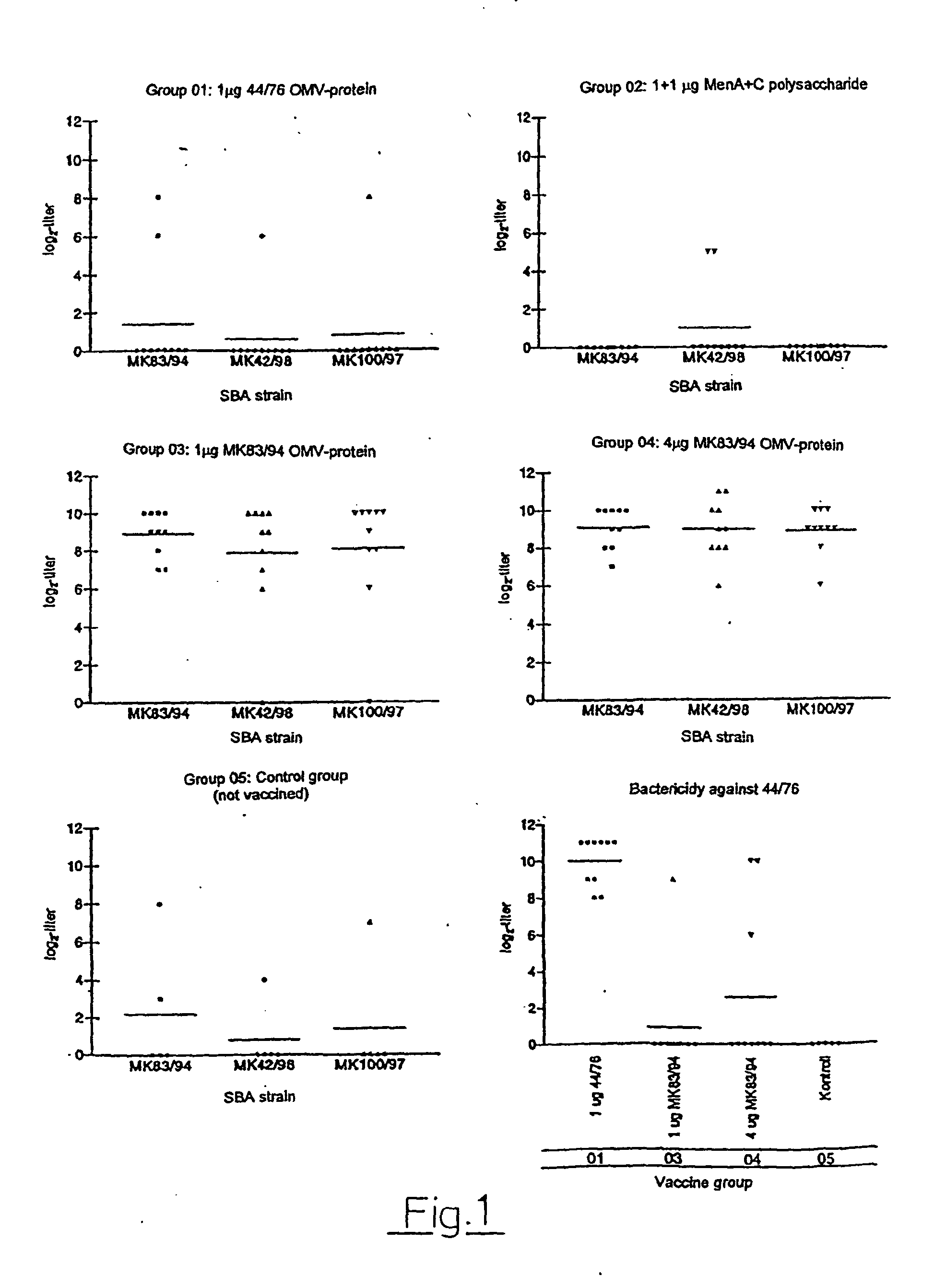Outer membrane vesicle vaccine against disease caused by neisseria meningitidis serogroup a and process for the production thereof
a technology of outer membrane and vesicle, which is applied in the field of outer membrane vesicle vaccine against disease caused by neisseria meningitidis serogroup a, can solve the problems of unfavorable and clear classification, unfavorable bacterial identification, and inability to give reliable and clear classification results, etc., to achieve the effect of strengthening the basis for vaccine production
- Summary
- Abstract
- Description
- Claims
- Application Information
AI Technical Summary
Benefits of technology
Problems solved by technology
Method used
Image
Examples
example 2
Preparation of an OMV Vaccine from a Meningococcal Serogroup B Strain 44 / 76 Grown in a Fermentor
[0123] a) Production and Purification of OMV
[0124] Cultivation of N. meningitidis 44 / 76 was initiated on growth on 6 Tryptone Soy Agar plates at 35.degree. C. in 5% CO.sub.2 / air atmosphere for 12 h. Cells were harvested into 3 tubes with 5 ml Frantz' medium. Contents of the tubes were added to. 3.times.1 l flasks containing Frantz' medium and grown by shaking over night to yield the inoculate. This was added to a Bioengineering LP351 fermentor with 75 l capacity, containing 51 l of pre-sterilised Frantz' modified medium and sterile-filtered yeast extract dialysate. The pH after inoculation was 7.06, falling to 6.39 during cultivation for 9 h at 36.degree. C. with stirring and aeration. Oxygen once had to be substituted for air when level of dissolved O.sub.2 approached zero. Growth was terminated at an OD.sub..lambda.650 nm of 6.36, the fermentor was cooled to 6.degree. C. by a cooling sy...
example 3
Preparation of an OMV Vaccine from a Meningococcal Serogroup A Strain
[0145] Meningococcal strain MK83 / 94 (Mali) is grown in a fermentor in Frantz' medium until early stationary growth, and OMV isolated and purified by the process of Example 2. OMV is characterized and found similar to OMV of Example 1.
example 4
Test of Two Serogroup A OMV Vaccines in Mice Serum Bactericidal Assay (SBA)
[0146] a) General Procedure
[0147] The efficiency of the vaccines from Examples 1 and 2, to provide protection against N. meningitidis strains was tested with the method of serum bactericidy, an assay believed to correlate with protection against meningococcal disease. A commercial polysaccharide group A+C vaccine was included as a control; such polysaccharide vaccines are known not to function well in SBA.
[0148] Sera from immunised (and non-immunised) mice were tested for their ability to kill selected bacteria. Mice used in the procedure were outbred NMRI female mice (weight 12-14 g), receiving 2 doses of vaccine with an interval of 3 weeks. Sera were obtained 2 weeks after the second immunisation.
[0149] The sera were tested for bactericidal properties against four different meningococcal test strains. In addition to the two serogroup A strains MK83 / 94 and MK100 / 97 used for preparation of vaccines (Example 1...
PUM
| Property | Measurement | Unit |
|---|---|---|
| Length | aaaaa | aaaaa |
| Fraction | aaaaa | aaaaa |
| Fraction | aaaaa | aaaaa |
Abstract
Description
Claims
Application Information
 Login to View More
Login to View More - R&D
- Intellectual Property
- Life Sciences
- Materials
- Tech Scout
- Unparalleled Data Quality
- Higher Quality Content
- 60% Fewer Hallucinations
Browse by: Latest US Patents, China's latest patents, Technical Efficacy Thesaurus, Application Domain, Technology Topic, Popular Technical Reports.
© 2025 PatSnap. All rights reserved.Legal|Privacy policy|Modern Slavery Act Transparency Statement|Sitemap|About US| Contact US: help@patsnap.com



